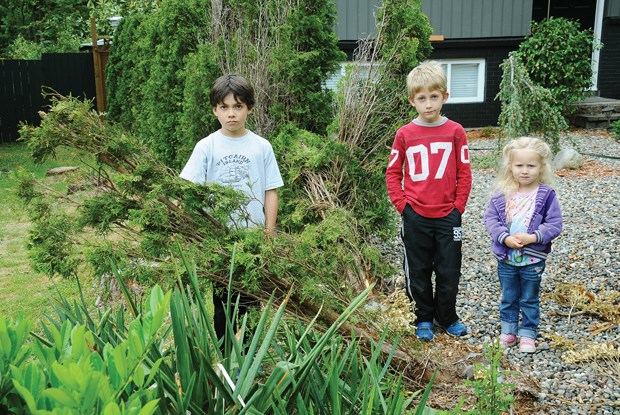Canyon Heights resident Kris Hartvigsen is wondering how many more vehicles have to crash onto his property before the District of North Vancouver implements some traffic calming measures on his street.
Hartvigsen recounted a recent frightening incident in which a driver roared down Cliffridge Avenue and, unable to negotiate the bend in the road, crashed right through the hedges in his front yard and was stopped only by a car in the neighbouring driveway.
Hartvigsen’s two kids typically would be standing in that spot on a Thursday at 8:40 a.m. — when the accident occurred — but they had left for school early that day. “I would have lost two children that day, that’s how dire the situation is,” said Hartvigsen.
Hartvigsen’s home is situated right at the end of the curve in the road on Cliffridge, which starts out steep and winds through a residential neighbourhood.
The traffic flows down through Canyon Heights with drivers, some who speed, coming onto Cliffridge to connect with the arterial route on Montroyal Boulevard. Neighbours have counted five significant accidents on Cliffridge in recent years, including one where a car flipped over and landed on Hartvigsen’s property.
Hartvigsen was hit by a sideview mirror on a speeding vehicle, while walking on his street with his daughter on his shoulders. “It was a minivan, and it was a mom, and she didn’t even stop. She was flying,” recalled Hartvigsen.
The close calls on Cliffridge have prompted residents to ask the district for traffic calming measures such as speed bumps, but they were told it would impede bus travel on that road.
“I recently said to the district, ‘On what planet are the performance and suspension of a bus more important than lives of children,” said Hartvigsen, who has lined up a company willing to put the speed bumps in for free.
The district’s traffic engineering department, however, says it’s not that simple and requires a study of the street and neighbourhood consultation. Gavin Joyce, the district’s general manager of Engineering, Parks and Facilities, said staff have visited Cliffridge since the latest incident and are currently gathering information such as vehicle volume and speed data to determine what further action should be taken.
Joyce said the first step usually involves speed enforcement such as a speed reader board and some RCMP presence on the street.
More permanent measures the district might consider are speed humps, which bring vehicles to an abrupt stop, or speed tables, which have a flat top with ramps on both sides, allowing for less of an impact on large vehicles like buses.
Under the district’s Local Area Service policy, currently being reviewed, the onus is on the residents to pay for traffic calming on non-collector roads, and requires 67 per cent approval from the homeowners. Joyce estimated it costs around $4,000 for a speed hump and $6,000 for a speed table.
In the recent case of Sunset Boulevard, there was majority support from the residents for speed humps or speed tables. But a counter petition from people who frequently drive on Sunset put those plans on hold.
The Sunset issue spawned a traffic calming policy review, which was discussed at a Committee of the Whole meeting Monday. Coun. Doug MacKay-Dunn is concerned the current policy gives way to a two-tier system in which affluent areas would be more likely to afford traffic calming.
Coun. Robin Hicks called for residents’ approval level to be raised to at least 75 per cent. Coun. Mathew Bond, saying it could be perceived that every local road needs to be traffic calmed, is hesitant to have the district pay for those measures.
Mayor Richard Walton, meanwhile, said traffic calming projects need to be placed in priority sequence, based on risk assessment, because “we don’t have an unlimited budget.”
District staff will report back to council with suggestions on whether or not to raise the required level of neighbourhood support, and when traffic calming requests on residential streets involve safety aspects, should the district pay for them.



